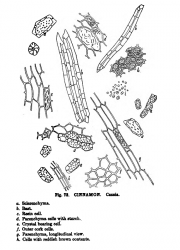|
AHPA recognizes other valuable resources exist regarding the identity of Cinnamomum loureiroi.
To submit a suggestion or contribution, please contact Merle Zimmermann.
|
Nomenclature
Cinnamomum loureirii Nees Lauraceae
Standardized common name (English): Saigon cinnamon
Botanical Voucher Specimen
Organoleptic Characteristics
Color Rather dark cinnamon brown (reddish brown).
Scent Fragrant, very aromatic.
Flavor Sweet, very pungent, astringent.
Source: Schneider, A. (1921) The Microanalysis of Powdered Vegetable Drugs, 2nd ed. [1]
|
|
|
|
Scent Aromatic.
Flavor Sweetish, armoatic, pungent.
Source: Culbreth, D. (1917) A Manual of Materia Media and Pharmacology, 6th ed. [2]
|
|
|
|
|
Macroscopic Characteristics
| Plants: Handsome evergreen trees, 6-9 M. (20-30°) high, trunk .3-.5 M. (12-18') thick, young twigs slightly quadrangular; leaves coriaceous, 3-5-nerved, but only midrib reaches apex, bright glossy-green above, glaucous beneath, 10-20 Cm. (4-8') long; flowers Jan.-March, small, hermaphrodite or polygamous, fleshy, black, ovoid, size of small olive, adhering, like acorn, to cup-shaped perianth.
Bark: (C. Loureirii, + --?): Saigon, in quills, 30 Cm. (12') long, 3-30 Mm. (1/8-1 1/5') broad; bark .5-3 Mm. (1/50-1/8') thick, light brown, dark purplish-brown with grayish patches of folaceous lichens and numerous bud-scars, finely wrinkled, especially that of younger twigs, otherwise rough from corky patches surrounding the lenticels; inner surface reddish-brown, granular, slightly striate; fracture short--inner bark porus from large oil and mucilage cells, and separated from the outer by a layer of stone cells.
Source: Culbreth, D. (1917) A Manual of Materia Media and Pharmacology, 6th ed. [3]
|
|
|
|
|
Microscopic Characteristics
| Histology much like that of Cassia; bast cells somewhat larger. Starch and sclerenchyma cells much as in Cinnamon aromaticum. Numerous small epidermal cells with thickened walls. Resin cells and crystals as in the other cinnamons.
Source: Schneider, A. (1921) The Microanalysis of Powdered Vegetable Drugs, 2nd ed. [4]
|
|
|
|
| Powder, yellowish-brown; microscopically--numerous starch grains, 0.003-.02 Mm. (1/8325-1/1250') broad, colorless stone cells, numerous cellular reddish-brown fragments, calcium oxalate raphides; Saigon has many cork cells, Ceylon [Ed-Syn. verum in text] few or none, while bast-fibres of former are in groups of 2-20, of latter single and fusiform.
Source: Culbreth, D. (1917) A Manual of Materia Media and Pharmacology, 6th ed. [5]
|
|
|
|
|
|
|

Source: Schneider, A. (1921) The Microanalysis of Powdered Vegetable Drugs, 2nd ed.[6]
|

Compare to Cinnamon aromaticum.
Source: Schneider, A. (1921) The Microanalysis of Powdered Vegetable Drugs, 2nd ed.[7]
|
|
High Performance Thin Layer Chromatographic Identification
Supplementary Information
Sources
- ↑ Schneider, A. (1921) The Microanalysis of Powdered Vegetable Drugs, 2nd ed.
- ↑ Culbreth, D. (1917) A Manual of Materia Media and Pharmacology, 6th ed.
- ↑ Culbreth, D. (1917) A Manual of Materia Media and Pharmacology, 6th ed.
- ↑ Schneider, A. (1921) The Microanalysis of Powdered Vegetable Drugs, 2nd ed.
- ↑ Culbreth, D. (1917) A Manual of Materia Media and Pharmacology, 6th ed.
- ↑ Schneider, A. (1921) The Microanalysis of Powdered Vegetable Drugs, 2nd ed.
- ↑ Schneider, A. (1921) The Microanalysis of Powdered Vegetable Drugs, 2nd ed.

